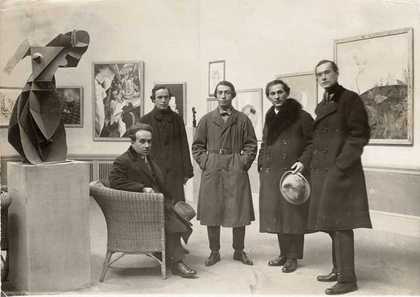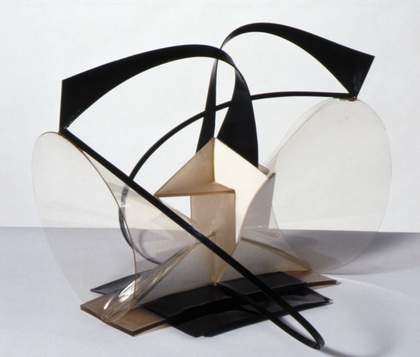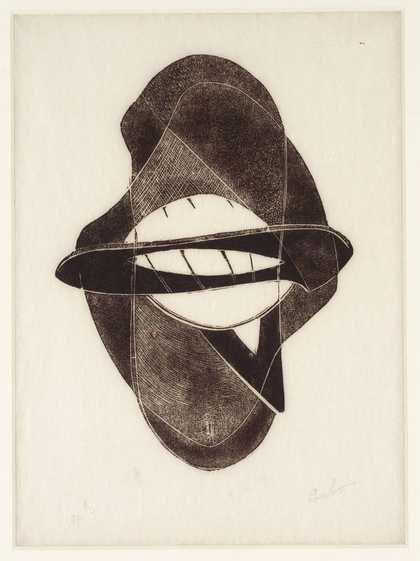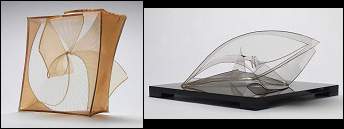
Fig.1
Naum Gabo
Construction in Space ‘Crystal’ 1937 and Spiral Theme 1941
Two cellulose acetate sculptures chosen as subjects for the pilot study
© Nina Williams
This paper describes the first phase of a multi-disciplinary research project that Tate is currently undertaking to document plastic sculptures by Naum Gabo. The project is a case study for a much wider debate about replicating art works. The Tate has the world’s largest collection of Gabo’s early sculptures, thanks to donations from the artist and his family. Despite storage in controlled conditions and a programme of regular monitoring, many of these are now showing signs of degradation due to the inherent instability of the plastics. This involves warping, sometimes crazing or misting and often cracking or breakage. We have long understood that our current knowledge of conservation might enable us to slow the onset of degradation but not to stop it and when these changes occur they are so sudden and irrevocable that there are no parallels in the field of sculpture. Research into documentation methods for these sculptures, and clarification how this information might be used in the future, is central to this project. From this follows the question of replication, the complexity of which determines the strand of debate for this workshop.
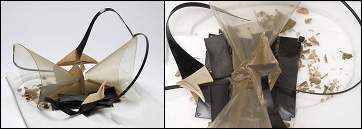
Fig.2
Naum Gabo
Construction in Space ‘Two Cones’ 1968
© Nina Williams
Forty-three of Tate’s Gabo sculptures are made wholly or partly from various types of plastic. The most acute problems arise from the seventeen works that include cellulose acetate and/or cellulose nitrate. We began by updating Tate’s conservation survey and identifying those sculptures most at risk using a scoring system based on different types of degradation that we observed. The survey of the sculpture collection is carried out routinely, but this was an opportunity to examine all the art works together and to try to assess both their current condition and their likelihood of degrading further so that a priority list could be drawn up.
There were other factors to take into account apart from just material degradation. Working closely with the curators, it was agreed that certain works should also be given a high priority because of their artistic importance. Considering the combination of these factors enabled us to determine which sculptures we thought most urgently needed detailed documentation. The next stage was to analyse the plastics in each work to ensure that we knew what we were dealing with.
Having traditionally documented the condition and material of which the sculptures are made, we wanted to find a suitable method for documenting them in three dimensions. This was a particularly challenging problem because of the sensitivity of the materials, the complexity of the shapes and the combination of reflective and transparent surfaces. Our research has led to a novel method that uses the three different techniques of laser scanning, photogrammetry and touch probe sensing in combination for the first time to obtain a three-dimensional computer model of the sculpture with an accuracy of around 0.5 mm. The two sculptures chosen for our pilot study were Gabo’s Spiral Theme 1941 and Construction in Space ‘Crystal’ 1937. Both are important works but were chosen for different reasons (as will be discussed at the workshop).

Fig.3
Probe data information for Construction in Space ‘Crystal’ and Spiral Theme
© Nina Williams
Laser scanning involves the use of laser light to measure the distance to an object in the laser’s field of view. The light strikes the object and scatters. Some of this reflected light is then returned back the way it came to be collected and focused onto an electronic imaging device. Laser scanning a shiny transparent object is difficult, however, for a number of reasons. Our laser scans for both sculptures showed that although the laser was able to pick up much of the surface, it missed some areas. As documentation of the entire surface was necessary, we needed another technique.
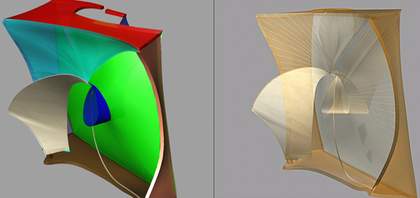
Fig.4
Naum Gabo
Construction in Space ‘Crystal’coloured to show the different sections from which this sculpture has been constructed
© Nina Williams
Photogrammetry was investigated as an additional three-dimensional documentation technique. This uses photography to measure spaces and objects by taking a number of photographs from different viewing positions of an object to give a three-dimensional network of two-dimensional images. A number of automatic and manual measurements are taken from these and fed into dedicated computer software for processing. The resulting data made it possible for us to measure parts of the sculpture in three-dimensional space between any two points on a photographic image.
Combining the results from photogrammetry and laser scanning certainly gave us far more three-dimensional information than we had dared to hope for when we started this project, but there were still limitations in both methods which meant we could still not accurately document the entire surface of the sculpture. A third, contact-based technique would therefore be necessary to supply this missing data.
The technique chosen was touch probe sensing. The touch probe is used to register exact points in space, which can make it possible to define accurately the geometry and shape of an object through a network of points. The fine probe head is gently placed onto the surface of the object wherever a measurement is needed. In our case the probe was used to define missing areas of surface detail and the accurate position of the edges. This is the only technique we used that required contact with the object’s surface but the probe head is sensitive and only minimal pressure needs to be applied. When the data from the three techniques was combined it was finally possible to construct accurate three-dimensional computer models of the two sculptures.
Conclusions and planned future research
The information gained using the combination of these three techniques has vastly improved our records for the two sculptures in the pilot study and will enable us to see changes over time by comparison with reliable data. The second phase of this project will now involve using the same techniques to create three-dimensional models for more of the Gabo sculptures on our priority list. We have set up our own in-house programme of photogrammetry allowing us to record the other Gabos in our collection and to archive their present condition. These photogrammetric images can be processed if further degradation occurs to give us accurate measurements of sculpture components and the ability to construct a basic outline model of each art work if required. These steps should ensure that the entire Gabo collection can be accurately documented in three dimensions.
The ability to capture detailed three-dimensional data opens up several options for the future. So far, these techniques have allowed us to record the current state of the Gabo sculptures which means that, in some cases, the three-dimensional model obtained will be from a sculpture that is already warped and damaged. An example is Gabo’s Circular Relief 1925–8. This sculpture has become distorted owing to degradation of the cellulose acetate sheet from which it has been made. Even if we do succeed in recording this sculpture in three dimensions, it will be considerably altered from its original appearance. We aim to investigate the possibilities for using computer software to help ‘virtually restore’ the sculpture models, using information from original photographs to create a virtual replica that is both dimensionally and visually accurate. This might make it possible for some of these sculptures to be viewed as the artist intended, although only in virtual form. It is crucial that we aim for as much accuracy in appearance and dimension as possible but there are dilemmas relating to whether we aim to represent visually the sculpture as it left the artist’s studio, from the date it came into the museum or as it is now.
More controversially, the accuracy of the three-dimensional data gives the opportunity to explore the creation of an actual replica using plastic sheet. We are looking into the feasibility of using software manipulation to separate the three-dimensional models into their component parts and to lay them flat. This would effectively give a two-dimensional cutting pattern for plastic sheet in much the same way that Gabo used carefully constructed templates to cut out the sections of his sculptures. These patterns should enable us to construct a replica with a high level of accuracy if this were ever considered appropriate. Whilst this project is about documentation as a conservation strategy, it is possible that more effective solutions will be found to help preserve the original sculptures but we are confident that these three-dimensional measurement techniques will offer us the best chance of capturing what we have today. At the material level, we are accumulating a wealth of data about specific sculptures. We now would like to explore how this should be used in the future.

